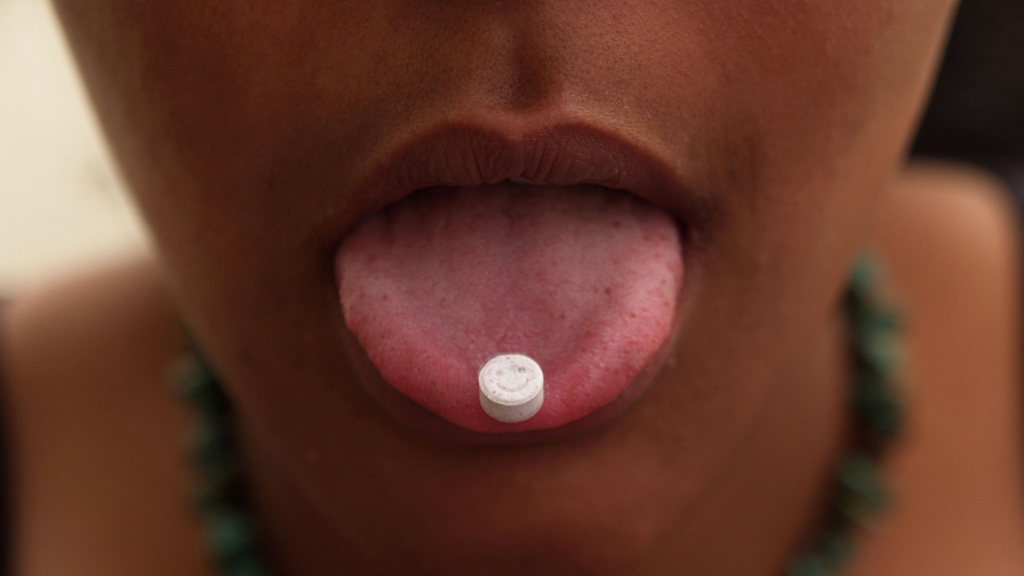Q and A: What is MDMA?
Ahead of the first live experiment of the effects of MDMA, Channel 4 News examines the drug, its effects and the extent of its use in the UK.

What is MDMA?
MDMA, or ecstasy, is a synthetic, psychoactive drug which most often takes the form of a pill. Its chemical name is the catchy 3-4 methylenedioxy-methamphetamine, and it has a strong impact on the body’s nervous system.
In chemical terms, it acts as both a stimulant and psychedelic. People take ecstasy to feel full of energy, happy and often report a higher level of confidence. The drug also influences people’s perceptions and can distort time, as well as enhancing tactile experiences.
Who takes it?
Nearly half a million people in the UK are believed to take ecstasy or MDMA every year. The Class A drug is associated with the rave scene of the late 80s and early 90s, but is still taken widely today. Clubbers took the drug to allow them to dance for longer and to stay awake for hours after taking the pill. A recent EU Drugs Agency study dubbed Britain the “drug-taking capital of Europe”.
What effect does it have on the body?
As well as a short term happiness and energy buzz, the main effects include a heightened awareness of surroundings, including colours and sounds, which is why it is often taken with music. Users also tend to feel loved-up, and develop temporary feelings of love and affection for the people they are with. But just like alcohol, the extent of the effects can vary from person to person. MDMA usually kicks in after half an hour of taking a pill, and the effects tend to wear off after between three to six hours, and this is followed by a comedown of a few days.
Read more: Drug legalisation debate may be missing the point
What are the hazards?
Short-term negative impacts of taking the drug can include feeling anxious or confused, jaw clenching, as well as being more at risk of panic attacks, according to the drugs advisory service Frank. Dehydration is also a short-term risk due to excessive activity in a hot environment and perspiration due to continuous movement or dancing, and a number of MDMA-related fatalities have been reported at raves.
The come-down after taking ecstasy can last for several days – a result of depleted levels of serotonin – and can make people feel depressed. Other reported negative long-term effects include depression and fatigue, and some studies also report that users can also develop paranoia, or even psychosis. However the results of studies are acknowledged to be hard to pin down because of compounding factors in participants, such as long-term use, use of other drugs and existing mental health.
Why is it illegal?
MDMA was made illegal in 1977, after a change in the Misuse of Drugs Act of 1971. Channel 4, and anyone else wanting to carry out experiments, need to get a licence from the Home Office to do so.
It is currently a Class A drug, and remains so despite a recommendation by the official Advisory Council on the Misuse of Drugs (ADMD) in 2009 that it be downgraded to Class B. The Home Office said this would send the message to young people that it takes the drug less seriously.
What is the Channel 4 study setting out to achieve?
The six-month long neuroscience study uses functional magnetic resonance imaging (fMRI) to examine the affect that MDMA has on the resting brain in healthy volunteers. It is the first experiment of its kind, designed by psycho-pharmacologists Professor Val Curran of University College London and Professor David Nutt of Imperial College London, who was sacked from the ACMD for saying that horse riding was statistically more dangerous than ecstasy.
The programme will also look at whether the results could be used in future studies to help inform the clinical treatment of Post Traumatic Stress Disorder (PTSD).
“This is the first study that will involve brain scans of people taking MDMA while not performing any tasks,” said Professor Nutt. “Imaging technology has improved enormously recently, so these experiments will give us a much clearer picture of the fundamental effects of MDMA on the resting brain than anyone has been able to get before.”
Read more: Number of children on antipsychotic drugs doubles
Why has there been criticism of the live experiment?
Some health campaigners, including the 2020Health think tank, have accused Channel 4 of glamorising drug-taking and said the programme is “publicity seeking”, while others have said that a controlled experiment will not give a true reflection of the impact that MDMA has on the brain.
“By choosing a banned substance for his experiment, Prof Nutt (who is not the leading UK neuroscientist in MDMA) has secured funding, controversy and an audience,” said 2020Health’s Julia Manning. “He’s giving an illicit drug publicity, taking a reductionist approach to its impact and claiming this study could indicate a worthy use for it.”
However those behind the experiment say that while it won’t demonstrate whether it is safe to take ecstasy in a club, it will improve understanding of how MDMA ” achieves its psychoactive effects”, says Professor Nutt. “This will help people to make decisions about drug-taking with more information about its potential harms and how to reduce the risks.”